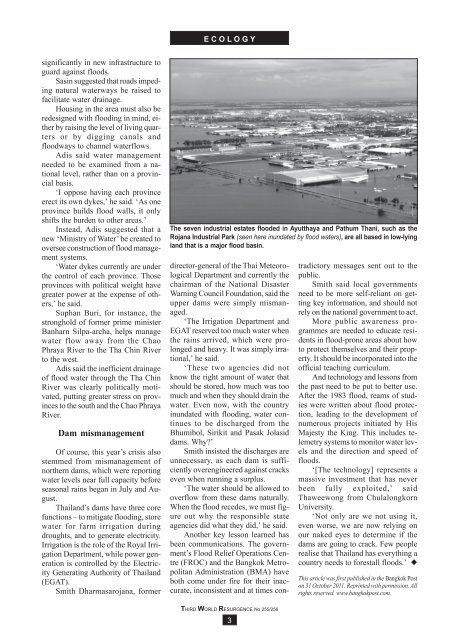Download - Third World Network
Download - Third World Network
Download - Third World Network
You also want an ePaper? Increase the reach of your titles
YUMPU automatically turns print PDFs into web optimized ePapers that Google loves.
E C O L O G Y<br />
significantly in new infrastructure to<br />
guard against floods.<br />
Sasin suggested that roads impeding<br />
natural waterways be raised to<br />
facilitate water drainage.<br />
Housing in the area must also be<br />
redesigned with flooding in mind, either<br />
by raising the level of living quarters<br />
or by digging canals and<br />
floodways to channel waterflows.<br />
Adis said water management<br />
needed to be examined from a national<br />
level, rather than on a provincial<br />
basis.<br />
‘I oppose having each province<br />
erect its own dykes,’ he said. ‘As one<br />
province builds flood walls, it only<br />
shifts the burden to other areas.’<br />
Instead, Adis suggested that a<br />
new ‘Ministry of Water’ be created to<br />
oversee construction of flood management<br />
systems.<br />
‘Water dykes currently are under<br />
the control of each province. Those<br />
provinces with political weight have<br />
greater power at the expense of others,’<br />
he said.<br />
Suphan Buri, for instance, the<br />
stronghold of former prime minister<br />
Banharn Silpa-archa, helps manage<br />
water flow away from the Chao<br />
Phraya River to the Tha Chin River<br />
to the west.<br />
Adis said the inefficient drainage<br />
of flood water through the Tha Chin<br />
River was clearly politically motivated,<br />
putting greater stress on provinces<br />
to the south and the Chao Phraya<br />
River.<br />
Dam mismanagement<br />
Of course, this year’s crisis also<br />
stemmed from mismanagement of<br />
northern dams, which were reporting<br />
water levels near full capacity before<br />
seasonal rains began in July and August.<br />
Thailand’s dams have three core<br />
functions – to mitigate flooding, store<br />
water for farm irrigation during<br />
droughts, and to generate electricity.<br />
Irrigation is the role of the Royal Irrigation<br />
Department, while power generation<br />
is controlled by the Electricity<br />
Generating Authority of Thailand<br />
(EGAT).<br />
Smith Dharmasarojana, former<br />
The seven industrial estates flooded in Ayutthaya and Pathum Thani, such as the<br />
Rojana Industrial Park (seen here inundated by flood waters), are all based in low-lying<br />
land that is a major flood basin.<br />
director-general of the Thai Meteorological<br />
Department and currently the<br />
chairman of the National Disaster<br />
Warning Council Foundation, said the<br />
upper dams were simply mismanaged.<br />
‘The Irrigation Department and<br />
EGAT reserved too much water when<br />
the rains arrived, which were prolonged<br />
and heavy. It was simply irrational,’<br />
he said.<br />
‘These two agencies did not<br />
know the right amount of water that<br />
should be stored, how much was too<br />
much and when they should drain the<br />
water. Even now, with the country<br />
inundated with flooding, water continues<br />
to be discharged from the<br />
Bhumibol, Sirikit and Pasak Jolasid<br />
dams. Why?’<br />
Smith insisted the discharges are<br />
unnecessary, as each dam is sufficiently<br />
overengineered against cracks<br />
even when running a surplus.<br />
‘The water should be allowed to<br />
overflow from these dams naturally.<br />
When the flood recedes, we must figure<br />
out why the responsible state<br />
agencies did what they did,’ he said.<br />
Another key lesson learned has<br />
been communications. The government’s<br />
Flood Relief Operations Centre<br />
(FROC) and the Bangkok Metropolitan<br />
Administration (BMA) have<br />
both come under fire for their inaccurate,<br />
inconsistent and at times contradictory<br />
messages sent out to the<br />
public.<br />
Smith said local governments<br />
need to be more self-reliant on getting<br />
key information, and should not<br />
rely on the national government to act.<br />
More public awareness programmes<br />
are needed to educate residents<br />
in flood-prone areas about how<br />
to protect themselves and their property.<br />
It should be incorporated into the<br />
official teaching curriculum.<br />
And technology and lessons from<br />
the past need to be put to better use.<br />
After the 1983 flood, reams of studies<br />
were written about flood protection,<br />
leading to the development of<br />
numerous projects initiated by His<br />
Majesty the King. This includes telemetry<br />
systems to monitor water levels<br />
and the direction and speed of<br />
floods.<br />
‘[The technology] represents a<br />
massive investment that has never<br />
been fully exploited,’ said<br />
Thaweewong from Chulalongkorn<br />
University.<br />
‘Not only are we not using it,<br />
even worse, we are now relying on<br />
our naked eyes to determine if the<br />
dams are going to crack. Few people<br />
realise that Thailand has everything a<br />
country needs to forestall floods.’ ÿu<br />
This article was first published in the Bangkok Post<br />
on 31 October 2011. Reprinted with permission. All<br />
rights reserved. www.bangkokpost.com.<br />
THIRD WORLD RESURGENCE No 255/256<br />
3
















